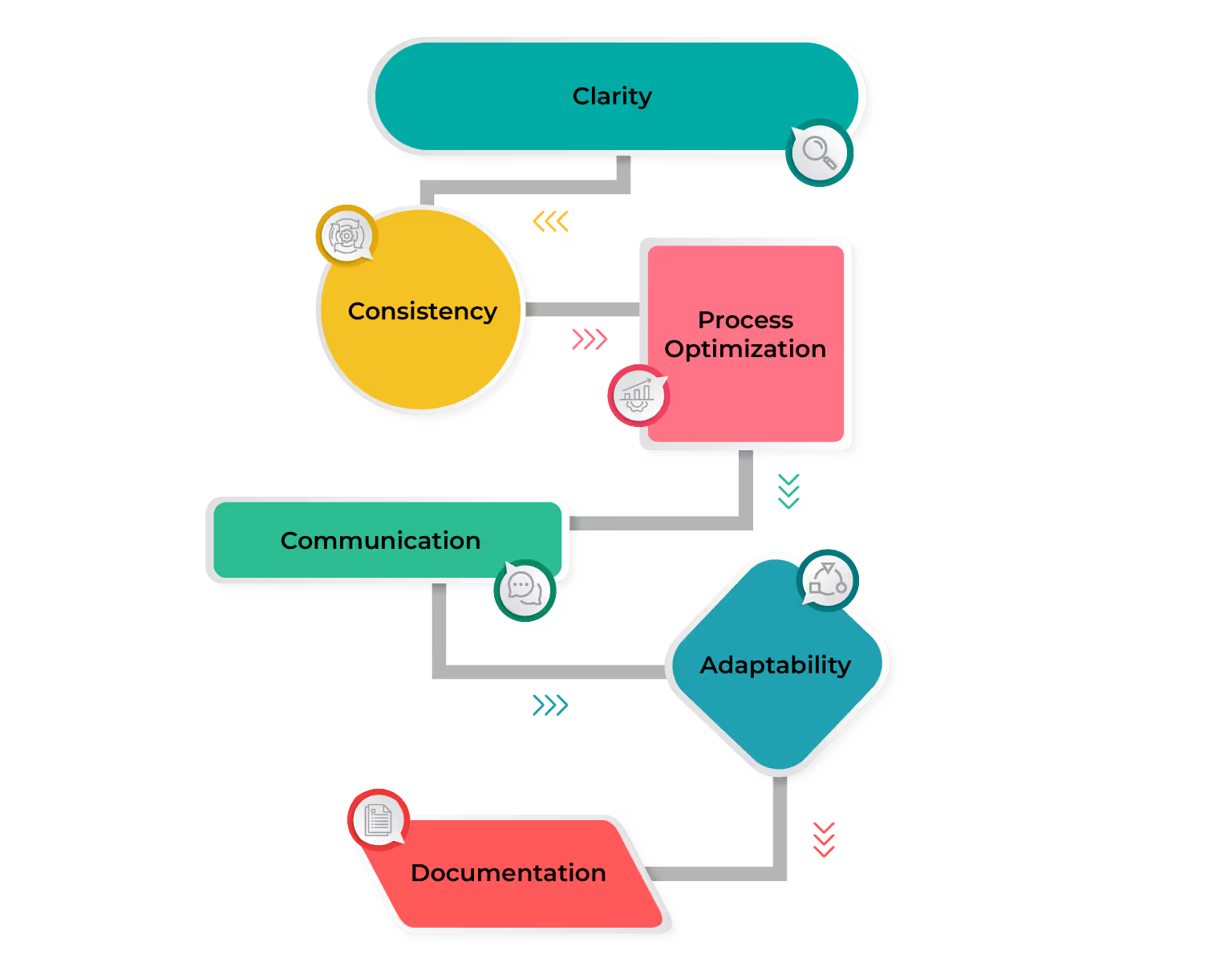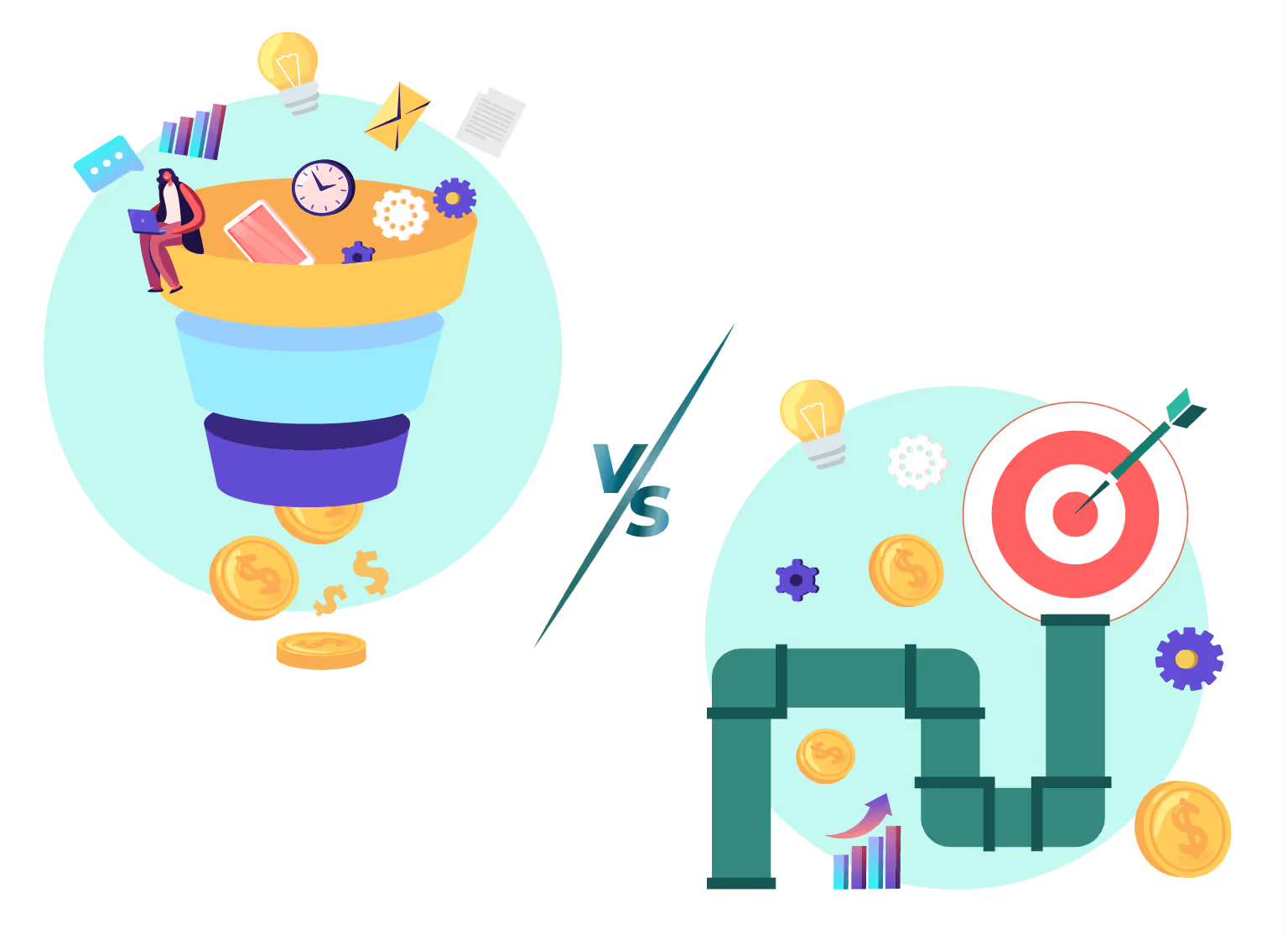
Blog
What Is a Sales Process Flowchart? A Comprehensive Guide
November 29, 2023


Key Insights
A core factor for the sales team's success lies in developing an efficient sales process.
But it's not just about building an effective sales process. There must be an ensuring that the sales framework gives a sense of direction and outlines the tasks and responsibilities of the people involved.
This requires a sales process roadmap in the form of a flowchart.
In this article, we will explore a sales process flowchart, the five steps involved in crafting a sales process flowchart, and the significance of it in enhancing your sales operations.
So scroll down for more.
What is Sales Process Flowcharts
A sales process flowchart is a visual representation of the steps involved in the sales process. It outlines the sequence of activities that a sales team follows to convert a potential customer into an actual customer.
B2B sales process flowchart typically starts with the initial contact with a lead and continues through the various stages until the deal is closed.
The benefits of Management by Objectives in this context are evident as it provides a structured framework for setting, communicating, and achieving sales goals, ensuring alignment between individual sales objectives and overall business objectives, ultimately enhancing the efficiency and success of the sales process.
Creating a sales process flowchart can be a collaborative effort involving various stakeholders. Additionally, this collaborative process serves as a foundational step in implementing a strategic sales improvement plan. Utilizing tools like a sales pipeline calculator ensures accurate planning and forecasting, enhancing overall sales strategy effectiveness.
Additionally, this collaborative process serves as a foundational step in implementing a strategic sales improvement plan, fostering continuous refinement and adaptation to enhance overall sales performance.
Five Steps for Crafting a Sales Process Flowchart
Crafting a sales process flowchart involves a systematic approach to ensure clarity, accuracy, and effectiveness. Here are five steps to guide you in crafting a basic sales process flowchart:

Define the Sales Process
The first step to building a sales process flowchart is to clearly outline the stages of your sales process, defining your sales process steps includes identifying key milestones from lead generation to closing the deal and mapping out the entire sales workflow. It includes the specific steps your team takes in moving a potential customer through the sales funnel such as lead qualification, initial contact, presentation, negotiation, closing, and post-sale activities.
Gather Input from Stakeholders
Building a sales process flowchart is a collaborative effort from key stakeholders, including sales representatives, managers, and other relevant team members. This involves collecting input on the existing sales process, common practices, and any variations in approaches. The collaborative approach ensures that the flowchart accurately reflects real-world processes.
Map Out the Steps
Flowchart symbols and shapes represent different steps and decision points in the sales process. Common symbols include rectangles for process steps, diamonds for decision points, and arrows to indicate the flow of the process. This creates a clear view of the step-by-step sales process which begins with lead generation and proceeds through each stage until reaching the closing of the deal.
Detail Each Step
For easy understanding, each step in the flow chart must provide detailed information. This involves including relevant information such as activities, responsibilities, criteria for moving to the next stage, and potential decision points. Being specific about the actions taken at each stage and the factors influencing those actions helps team members follow the flowchart accurately.

Review and Refine
Every tool requires a regular and thorough review. Conducting a flowchart review with stakeholders will ensure that it accurately represents the current sales process and incorporates feedback from team members. Finding newer ways to streamline the process, and eliminate redundancies helps in enhancing clarity and refining the flowchart for improvement.
A sales process flowchart is a dynamic document that must be updated as your business evolves. This regular review helps ensure that the flowchart remains an accurate and effective tool for guiding your sales team, aligning their efforts with broader organizational objectives, such as achieving sales OKR examples.
It also facilitates the identification and incorporation of changes in sales team roles and responsibilities, ensuring that the evolving needs of the team are seamlessly integrated into the overall sales process for optimal performance.
For further reading, check A Guide to Optimising Sales Performance for the Sales Process.
Significance of a Sales Process Flowchart
The significance of a sales process flowchart lies in its ability to provide a visual representation of the steps involved in the sales cycle. Let us look at why a sales process flowchart is significant to your sales management.
Additionally, it plays a crucial role in sales funnel management, offering a clear and structured overview that helps in monitoring and optimizing each stage of the sales funnel for enhanced efficiency and conversion.

Clarity
A B2B sales process flowchart provides a clear and visual representation of the sales process, making it easy for team members to understand and follow. The detailed step-by-step guide to the sales process, helps sales representatives understand the stages involved, their roles, and the overall workflow.
Consistency
An effective sales flowchart ensures a consistent and standardized approach to sales. Creating and implementing an effective sales process flowchart helps all team members follow the same process ensuring and maintaining consistency in how leads are approached, qualified, and converted into customers.
Process Optimization
Incorporating a flowchart, especially during the kick-off sales phase, highlights inefficiencies and helps identify areas where the sales process can be improved. Gaining these valuable insights during the kick-off sales is crucial for the continuous optimization and improvement of the sales process.
Communication
The sales process flowchart ensures lucid communication within the team. Sharing the flowchart with the team members ensures that everyone is on the same page regarding the sales process. In addition, it also helps the whole team understand where a lead is in the sales process, making it easier to collaborate and communicate effectively.
Adaptability
A sales process flowchart is a dynamic and adaptable tool that can be customized based on the industry you belong to or the product you sell. The flowchart can be adapted to suit the unique characteristics of a particular industry or product, ensuring that the sales process aligns with the specific requirements of the business. Incorporating a sales accelerator into the flowchart enhances its efficiency and effectiveness.
Documentation
A sales process flowchart also serves as a documented reference for the entire sales team, providing a quick and accessible guide that can be referred to at any point. It helps monitor and track the strategies incorporated to make the pipeline journey smooth and quick and the efficacy of the sales process in converting prospects and closing deals.
A sales process flowchart is a powerful tool for enhancing the efficiency, effectiveness, and consistency of the sales process.
For further reading, check A Step-by-Step Guide to the MEDDIC Sales Qualification Process.
Conclusion
A wide variety of tools provides clarity and visibility to your sales process. Approaches to sales planning, sales flowchart, sales methodologies are a few examples of these tools. It helps motivate the team and helps them focus on their goals.
Sales process flowchart fulfills all these requirements and more. From providing clarity on the sales process and consistency in the sales approach to optimizing operations, enhancing communication, and adaptability, there are several benefits it offers to your sales management.
These steps are crucial as it is efficient and streamline sales management ensuring consistent business growth and success.
Kennect builds, runs, and automates your incentive compensation plans to create transparency and achieve operational efficiency.
ReKennect : Stay ahead of the curve!
Subscribe to our bi-weekly newsletter packed with latest trends and insights on incentives.
Thank you! Your submission has been received!
Oops! Something went wrong while submitting the form.
Your data is in safe hands. Check out our Privacy policy for more info















